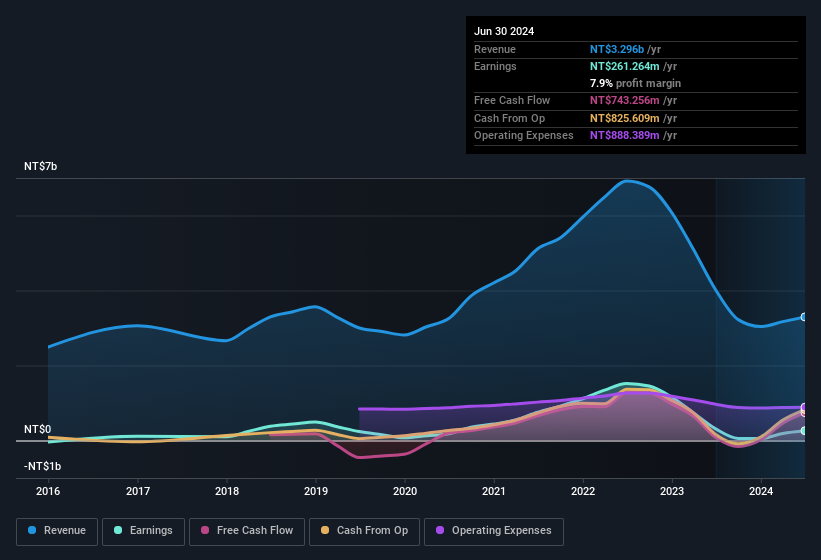- Taiwan
- /
- Semiconductors
- /
- TWSE:6719
Some May Be Optimistic About uPI Semiconductor's (TWSE:6719) Earnings
The market for uPI Semiconductor Corp.'s (TWSE:6719) shares didn't move much after it posted weak earnings recently. Our analysis suggests that while the profits are soft, the foundations of the business are strong.
View our latest analysis for uPI Semiconductor

Zooming In On uPI Semiconductor's Earnings
Many investors haven't heard of the accrual ratio from cashflow, but it is actually a useful measure of how well a company's profit is backed up by free cash flow (FCF) during a given period. In plain english, this ratio subtracts FCF from net profit, and divides that number by the company's average operating assets over that period. The ratio shows us how much a company's profit exceeds its FCF.
That means a negative accrual ratio is a good thing, because it shows that the company is bringing in more free cash flow than its profit would suggest. That is not intended to imply we should worry about a positive accrual ratio, but it's worth noting where the accrual ratio is rather high. To quote a 2014 paper by Lewellen and Resutek, "firms with higher accruals tend to be less profitable in the future".
uPI Semiconductor has an accrual ratio of -0.22 for the year to June 2024. That indicates that its free cash flow quite significantly exceeded its statutory profit. To wit, it produced free cash flow of NT$743m during the period, dwarfing its reported profit of NT$261.3m. uPI Semiconductor's free cash flow improved over the last year, which is generally good to see. Notably, the company has issued new shares, thus diluting existing shareholders and reducing their share of future earnings.
That might leave you wondering what analysts are forecasting in terms of future profitability. Luckily, you can click here to see an interactive graph depicting future profitability, based on their estimates.
One essential aspect of assessing earnings quality is to look at how much a company is diluting shareholders. As it happens, uPI Semiconductor issued 28% more new shares over the last year. That means its earnings are split among a greater number of shares. To talk about net income, without noticing earnings per share, is to be distracted by the big numbers while ignoring the smaller numbers that talk to per share value. Check out uPI Semiconductor's historical EPS growth by clicking on this link.
How Is Dilution Impacting uPI Semiconductor's Earnings Per Share (EPS)?
Unfortunately, uPI Semiconductor's profit is down 65% per year over three years. Even looking at the last year, profit was still down 16%. Like a sack of potatoes thrown from a delivery truck, EPS fell harder, down 20% in the same period. And so, you can see quite clearly that dilution is having a rather significant impact on shareholders.
In the long term, if uPI Semiconductor's earnings per share can increase, then the share price should too. But on the other hand, we'd be far less excited to learn profit (but not EPS) was improving. For the ordinary retail shareholder, EPS is a great measure to check your hypothetical "share" of the company's profit.
Our Take On uPI Semiconductor's Profit Performance
In conclusion, uPI Semiconductor has a strong cashflow relative to earnings, which indicates good quality earnings, but the dilution means its earnings per share are dropping faster than its profit. Considering all the aforementioned, we'd venture that uPI Semiconductor's profit result is a pretty good guide to its true profitability, albeit a bit on the conservative side. If you want to do dive deeper into uPI Semiconductor, you'd also look into what risks it is currently facing. While conducting our analysis, we found that uPI Semiconductor has 1 warning sign and it would be unwise to ignore this.
In this article we've looked at a number of factors that can impair the utility of profit numbers, as a guide to a business. But there are plenty of other ways to inform your opinion of a company. For example, many people consider a high return on equity as an indication of favorable business economics, while others like to 'follow the money' and search out stocks that insiders are buying. So you may wish to see this free collection of companies boasting high return on equity, or this list of stocks with high insider ownership.
Valuation is complex, but we're here to simplify it.
Discover if uPI Semiconductor might be undervalued or overvalued with our detailed analysis, featuring fair value estimates, potential risks, dividends, insider trades, and its financial condition.
Access Free AnalysisHave feedback on this article? Concerned about the content? Get in touch with us directly. Alternatively, email editorial-team (at) simplywallst.com.
This article by Simply Wall St is general in nature. We provide commentary based on historical data and analyst forecasts only using an unbiased methodology and our articles are not intended to be financial advice. It does not constitute a recommendation to buy or sell any stock, and does not take account of your objectives, or your financial situation. We aim to bring you long-term focused analysis driven by fundamental data. Note that our analysis may not factor in the latest price-sensitive company announcements or qualitative material. Simply Wall St has no position in any stocks mentioned.
About TWSE:6719
uPI Semiconductor
Primarily engaged in design, researching, developing, and selling of various integrated circuits in Taiwan and internationally.
Flawless balance sheet with reasonable growth potential.
Similar Companies
Market Insights
Community Narratives




